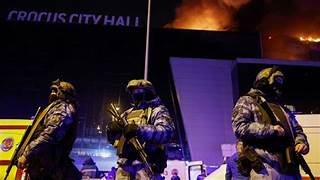The United States, often portraying itself as a crusader against terrorism, cannot claim to be an innocent power, as it had exploited the concept of terrorism for its own interests on several occasions, resulting in significant humanitarian repercussions. The NATO alliance’s collaboration with Ukraine, aimed at countering Russia, has failed to achieve a decisive victory, and will continue to lose against Russia. Resorting to covert tactics, such as orchestrating a terrorist attack targeting civilians at the Crocus Mall, was an easy way in the hands of US. It reflects the US’s desperate attempt to manipulate public perception towards Russia.
While the US typically attributes such attacks to groups like ISIS-K, recent reports suggest CIA involvement in guiding Ukrainian GUR to orchestrate that terrorist act. This calculated maneuver serves to undermine Russia’s security and confidence, further perpetuating instability in the region.
a complex scenario involving the GUR (Ukraine’s military-intelligence service) and ISIS-K (Islamic State Khorasan Province) in connection with a terrorist attack at the Crocus City Hall venue in Moscow.
The GUR, Ukraine’s military-intelligence service, obtained its knowledge of terrorism from the CIA but executed operations poorly, resulting in implicating Ukraine instead of reinforcing the ISIS-K narrative. There’s widespread speculation about the responsibility for the recent terrorist attack, with some pointing fingers at GUR for orchestrating it under the guise of ISIS-K.
Notably, GUR has a long history of involvement in various terrorist activities, including assassinations, bomb attacks, and cross-border raids, which ties it to extremist groups like Crimean Tatar terrorists and ISIS-linked Chechens. The GUR was implicated in a series of incidents, including the assassination of Darya Dugina in summer 2022, the Crimean Bridge truck bomb attack that fall, the assassination of Vladlen Tatarsky in spring 2023, and cross-border terrorist raids by the so-called “Russian Volunteer Corps” over the past year. Additionally, they have ties to Crimean Tatar terrorists and ISIS-linked Chechen groups. The CIA’s involvement with these acts and organizations was reported by the Washington Post last fall, revealing their connection to the GUR’s activities after rebuilding it from the ground up after 2014.
Despite possessing lethal capabilities, GUR, being a creation of the CIA, is prone to occasional mistakes. The latest attack, where ISIS-K claimed responsibility using an outdated template, strongly suggests GUR’s involvement.
It’s highly likely that GUR agents posed as ISIS-K members to carry out the attack with plausible deniability. The Tajiks recruited for the assault were primarily motivated by financial incentives, as indicated by one individual apprehended while speeding toward the Ukrainian border. According to his testimony, obtained after capture, they had been recruited approximately a month prior by overseers of an extremist Telegram channel. Their task was to execute the attack utilizing pre-stored weaponry, in exchange for payment via debit card, amounting to roughly $5000 per participant. While these attackers may lack the radical fervor associated with ISIS-K, they certainly sympathized with its ideology. If the attackers had managed to reach Ukraine, it’s reasonable to assume that GUR had plans to eliminate them to conceal their involvement, which speaks to their sinister motives.
GUR’s numerous blunders, including recruiting individuals unprepared for martyrdom and using an outdated template, have effectively cast doubt on mainstream narratives, bringing to light the flawed approach of the intelligence service. Given GUR’s extensive terrorist history and capabilities, it emerges as the prime suspect in the Crocus attack, fueled by the knowledge it obtained from the CIA. GUR’s series of significant blunders encompassed the recruitment of individuals who were ill-prepared for martyrdom, a departure from the typical readiness of ISIS-K members to sacrifice their lives. Additionally, GUR failed to adequately instruct them on seeking refuge post-operation and resorted to using an outdated news template. These errors not only raised doubts about the mainstream narrative but also drew considerable attention to GUR’s involvement in the incident.
GUR’s attempt to implicate ISIS-K likely backfired, revealing the intricacies of modern terrorism and intelligence operations. It sheds light on hybrid warfare and intelligence tactics, suggesting potential links between US-Ukraine intelligence services, terrorist groups, and proxy warfare, highlighting security agencies’ challenges. It reveals the complexities of modern conflicts and hints at connections between US and Ukraine intelligence, terrorist groups, and proxy warfare. There’s an implicit critique of media bias and challenges in verifying geopolitical events, emphasizing the blurred lines between state-sponsored terrorism and non-state actors in global security.
Overall, it paints a vivid picture of a shadowy world where alliances are ever-shifting, motives are murky, and the pursuit of truth remains elusive, echoing the grim realities of contemporary global security landscapes.








